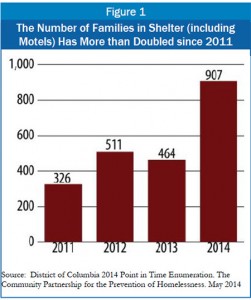Chairman Graham and members of the committee, thank you for the opportunity to testify today. My name is Kate Coventry, and I am a policy analyst with the DC Fiscal Policy Institute. DCFPI engages in research and public education on the fiscal and economic health of the District of Columbia, with a particular emphasis on how policies impact low- and moderate-income families.
I am here today to testify in support of three areas that will help improve services for homeless families in the District. A new homelessness prevention program can help some families avoid homelessness, a new playground at DC General can give children who are homeless a safe space to play, and the “Dignity for Homeless Families Amendment Act” can help ensure families are sheltered in safe places. On the latter, we also suggest that the Council add an amendment allowing families to not only be safely shelter, but continuously sheltered until they find a suitable housing alternative.
A More Targeted and Enhanced Homelessness Prevention Program Is A Critical Tool for the District to Address the Rise In Homelessness
While shelter is better for families than sleeping in cars or other unsafe locations, research has consistently found that parent and child wellbeing decline while a family is in shelter. Preventing families from becoming homeless can help families avoid these negative effects. DCFPI supports the creation of a new homelessness prevention program in the fiscal year 2015 “Budget Support Act of 2014″. The new program builds on discussions the Interagency Council on Homelessness (ICH) has had and was a recommendation from 26 community organizations, including DCFPI, in the Helping Families Home: A Roadmap for the District. The roadmap lays out the actions the District must take from now until next spring to put DC on a path to a system that serves families appropriately with the goal of quickly connecting families with the right services.
The ICH developed a goal of improving prevention efforts as part of its five-year Strategic Plan in 2010. However due to lack of new funding few improvements have been made since the Plan’s adoption. After seeing a record number of families in shelter this past hypothermia (see Figure 1), the ICH Operations and Logistics Committee began discussing the possibility of a new homelessness prevention program, potentially modeled after New York City’s Homebase program.
Homebase uses an assessment tool to identify the families most likely to enter shelter and provides these families with ongoing case management and service referrals. Some families receive limited financial assistance for rental arrearages. In New York, those provided with prevention assistance were half as likely to apply for shelter as a control group of families not provided with assistance.
The FY 2015 budget that was recently approved by the Council includes $2 million and Budget Support Act language that would create a program similar to NYC’s Homebase. DCFPI supports the creation of this program and hopes to work with the ICH, the Committee on Human Services, DHS and other community groups to have a program in place before the start of FY 2015 hypothermia season to help the anticipated annual surge of families seeking housing assistance.
This new prevention program will differ from the District’s current prevention program, the Emergency Rental Assistance Program (ERAP), because it will provide case management and service referrals as well as the rental arrearages provided by ERAP. These services can include connecting a parent with employment services, including reconnecting Temporary Assistance for Needy Families (TANF) families with their vendors if needed. Families who do not qualify for TANF will be referred to Department of Employment Services (DOES) or community-based services if needed. The program will also differ from ERAP because it will target families most likely to become homeless. Lastly, additional services will be located in a number of community locations, making it easier for residents to access and lessening the caseload at the Virginia Williams Family Resource Center that can lead to long wait times.
This prevention program will also serve as an important resource for the District’s TANF redesign, an effort in which the District has invested tens of millions of dollars. I have visited six of the seven TANF Employment Program vendors, and all six report that housing instability is the biggest barrier to regular program participation and to securing employment for their clients. Parents often spend days searching for assistance. The client then gets sanctioned for being unable to meet the obligations of their Individual Responsibility Plan, meaning their already insufficient TANF benefits could also be reduced. TANF vendors will be able to refer families to this prevention program avoiding the long wait times at the Virginia Williams Family Resource Center.
To read the complete testimony, click here.

